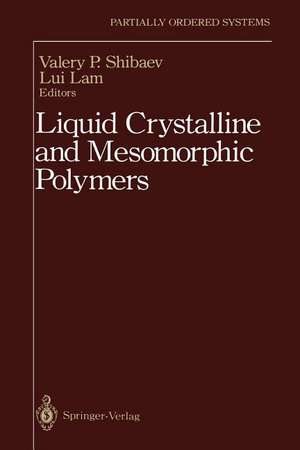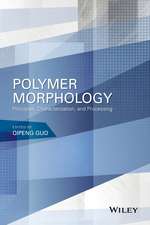Liquid Crystalline and Mesomorphic Polymers: Partially Ordered Systems
Editat de Valery P. Shibaev, Lui Lamen Limba Engleză Paperback – 6 noi 2011
Preț: 644.49 lei
Preț vechi: 758.23 lei
-15% Nou
Puncte Express: 967
Preț estimativ în valută:
123.33€ • 131.88$ • 102.82£
123.33€ • 131.88$ • 102.82£
Carte tipărită la comandă
Livrare economică 18 aprilie-02 mai
Preluare comenzi: 021 569.72.76
Specificații
ISBN-13: 9781461383352
ISBN-10: 1461383358
Pagini: 380
Ilustrații: XVI, 361 p.
Dimensiuni: 155 x 235 x 20 mm
Greutate: 0.53 kg
Ediția:Softcover reprint of the original 1st ed. 1994
Editura: Springer
Colecția Springer
Seria Partially Ordered Systems
Locul publicării:New York, NY, United States
ISBN-10: 1461383358
Pagini: 380
Ilustrații: XVI, 361 p.
Dimensiuni: 155 x 235 x 20 mm
Greutate: 0.53 kg
Ediția:Softcover reprint of the original 1st ed. 1994
Editura: Springer
Colecția Springer
Seria Partially Ordered Systems
Locul publicării:New York, NY, United States
Public țintă
ResearchCuprins
1 Molecular Theory of Cholesteric Polymers.- 1.1 Introduction.- 1.2 Elementary Models for Chiral Molecules.- 1.3 Chiral Anisotropic Interaction Between Macromolecules in the Solvent.- 1.4 Statistical Theory of Cholesteric Ordering.- 1.5 Influence of Molecular Flexibility on the Cholesteric Ordering in Polymer Solutions.- References.- 2 Structure of Thermotropic Main-Chain Polymers.- 2.1 Introduction.- 2.2 Molecular Architecture.- 2.3 Levels of Order in Mesophases of Main-Chain Liquid Polymers.- References.- 3 Molecular Architecture and Structure of Thermotropic Liquid Crystal Polymers with Mesogenic Side Groups.- 3.1 Introduction.- 3.2 Molecular Architecture of Liquid Crystal Polymers.- 3.3 Specific Features of Comb-Shaped Polymers Associated with Their Macromolecular Nature.- 3.4 Mesophase Types of Comb-Shaped Liquid Crystal Polymers. Problems of Classification.- 3.5 Effect of Mesophase Type on the Structure of Polymers Oriented by Uniaxial Drawing.- 3.6 Placement of the Main-Chain in Smectic and Nematic Phases of Comb-Shaped Liquid Crystal Polymers.- 3.7 Structure of Cholesteric Polymers.- References.- 4 Phase Behavior of High- and Low-Molar-Mass Liquid Crystal Mixtures.- 4.1 Introduction.- 4.2 Binary Mixtures of Low-Molar-Mass Mesogens.- 4.3 Mixtures of a Liquid Crystalline Polymer with a Low-Molar-Mass Liquid Crystal.- 4.4 Conclusions.- References.- 5 Polymer-Dispersed Liquid Crystal Films.- 5.1 Introduction.- 5.2 Film Structure and Operation.- 5.3 Film Formation: General Aspects.- 5.4 Polymer-Dispersed Liquid Crystal Formation: Polymer-Induced Phase Separation Systems.- 5.5 Materials Selection.- 5.6 Film Fabrication and Morphology.- 5.7 Electrooptic Properties.- 5.8 Light Scattering.- 5.9 Final Comments.- References.- 6 Nuclear Magnetic Resonance Spectroscopy of Thermotropic Liquid Crystalline Polymers.- 6.1 Introduction.- 6.2 Thermotropic Liquid Crystalline Polymers with Mesogenic Groups in the Main Chain.- 6.3 Liquid Crystalline Polymers with Mesogenic Groups in the Side Chains.- References.- 7 Mesophase of Graphitizable Carbons.- 7.1 Introduction.- 7.2 Discotic Nematic Liquid Crystals.- 7.3 Formation of the Mesophase.- 7.4 Structure in the Mesophase.- 7.5 Growth and Coalescence.- 7.6 Formation of Anisotropic Carbons.- 7.7 Factors Influencing the Formation of Anisotropic Carbons.- 7.8 Graphitization.- 7.9 Industrial Relevance of Mesophase: Discotic, Aromatic, and Nematic Liquid Crystals.- References.- 8 Mesophase State of Polyorganophosphazenes.- 8.1 Introduction.- 8.2 Thermodynamics and Structure of Polyorganophosphazenes.- 8.3 Relaxation Transitions of Poly-bis-Trifluoroethoxyphosphazenes.- 8.4 Properties of Diluted Solutions of Poly-bis-Fluoroalkoxyphosphazenes.- 8.5 Rheological Properties of Concentrated Poly-bis-Trifluoroethoxyphosphazene Solutions.- 8.6 Rheological Properties of Poly-bis-Fluoroalkoxyphosphazenes in the Mesophase State.- 8.7 Polymer Blends on a Base of Poly-bis-Trifluoroethoxyphosphazene.- 8.8 Conclusions.- References.- 9 Chiral Nematic Mesophases of Lyotropic and Thermotropic Cellulose Derivatives.- 9.1 Mesophase Formation.- 9.2 Mesophases of Cellulose Derivatives.- 9.3 Chiral Nematic Properties.- 9.4 Circular Dichroism and Induced Circular Dichroism.- 9.5 Chiroptical Properties of Specifically Substituted Cellulose Derivatives.- 9.6 Concluding Remarks.- References.- 10 Bowlics.- 10.1 Introduction.- 10.2 The First Paper.- 10.3 Bowlic Monomers.- 10.4 Bowlic Polymers.- 10.5 Conclusions.- References.






















